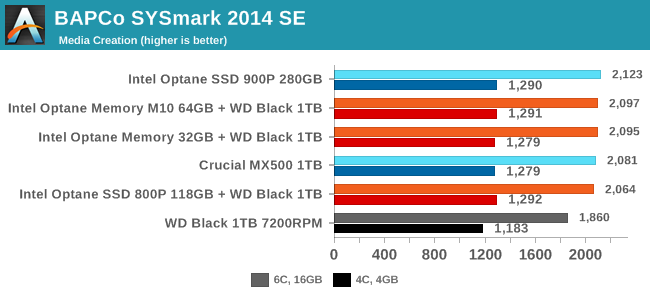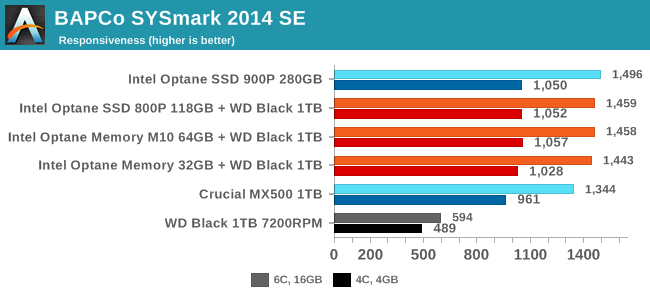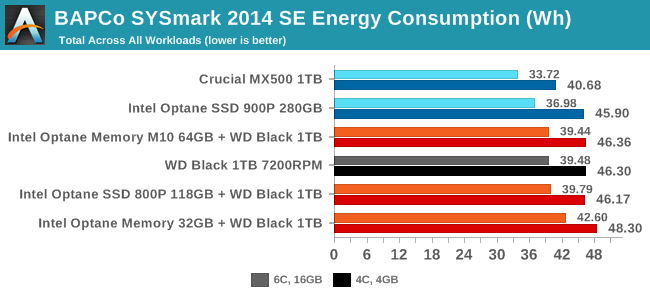The Intel Optane Memory M10 (64GB) Review: Optane Caching Refreshed
by Billy Tallis on May 15, 2018 10:45 AM EST- Posted in
- SSDs
- Storage
- Intel
- PCIe SSD
- SSD Caching
- M.2
- NVMe
- Optane
- Optane Memory
BAPCo SYSmark 2014 SE
BAPCo's SYSmark 2014 SE is an application-based benchmark that uses real-world applications to replay usage patterns of business users in the areas of office productivity, media creation and data/financial analysis. In addition, it also addresses the responsiveness aspect which deals with user experience as related to application and file launches, multi-tasking etc. Scores are calibrated against a reference system that is defined to score 1000 in each of the scenarios. A score of, say, 2000, would imply that the system under test is twice as fast as the reference system.
SYSmark scores are based on total application response time as seen by the user, including not only storage latency but time spent by the processor. This means there's a limit to how much a storage improvement could possibly increase scores, because the SSD is only in use for a small fraction of the total test duration. This is a significant difference from our ATSB tests where only the storage portion of the workload is replicated and disk idle times are cut short to a maximum of 25ms.
For this review, SYSmark has been used on two different machines: a relatively high-end system with a six-core Intel Core i7-8700K processor and 16GB of RAM, and a more limited system with a quad-core Intel Core i5-7400 processor and just 4GB of RAM. The low-end system spends a lot of time swapping thanks to its small amount of RAM, and this adds greatly to the storage workload.
| AnandTech SYSmark SSD Testbed | |
| CPU | Intel Core i7-8700K |
| Motherboard | Gigabyte Aorus H370 Gaming 3 WiFi |
| Chipset | Intel H370 |
| Memory | 2x 8GB Kingston DDR4-2666 |
| Case | In Win C583 |
| Power Supply | Cooler Master G550M |
| OS | Windows 10 64-bit, version 1709 |
| AnandTech SYSmark SSD Low-End Testbed | |
| CPU | Intel Core i5-7400 |
| Motherboard | ASUS PRIME Z270-A |
| Chipset | Intel Z270 |
| Memory | 1x 4GB Corsair DDR4-2666 |
| Case | In Win C583 |
| Power Supply | Cooler Master G550M |
| OS | Windows 10 64-bit, version 1709 |
None of the Optane Memory modules are large enough to serve as a Windows boot drive alone as well as storing all the applications used for SYSmark, so this section only tests the Optane Memory and Optane SSD 800P as cache drives. (The 118GB Optane SSD 800P is pretty much the smallest drive that can could run SYSmark, but it doesn't leave much room for user data.)



The Data/Financial Analysis, Media Creation, and Office Productivity sub-tests are all relatively insensitive to storage performance, and they are shown in order of decreasing sensitivity to the CPU and RAM differences between the two test systems. These results show that a mechanical hard drive can hold back application performance, but almost any solid state storage system—including Optane Memory caching—is sufficient to shift the bottlenecks over to compute and memory.

The Responsiveness test is less focused on overall computational throughput and more on those annoying delays that make a computer feel slow: application launching, opening and saving files, and a variety of multitasking scenarios. Here, moving off a mechanical hard drive is by far the best upgrade that can be made to improve system performance. Going beyond a mainstream SATA SSD provides diminishing returns, but there is a measurable difference between the SATA SSD and the fastest Optane SSD.
Energy Usage
The SYSmark energy usage scores measure total system power consumption, excluding the display. Our SYSmark test system idles at around 26 W and peaks at over 60 W measured at the wall during the benchmark run. SATA SSDs seldom exceed 5 W and idle at a fraction of a watt, and the SSDs spend most of the test idle. This means the energy usage scores will inevitably be very close. A typical notebook system will tend to be better optimized for power efficiency than this desktop system, so the SSD would account for a much larger portion of the total and the score difference between SSDs would be more noticeable.

The Intel Optane SSD 900P is quite power-hungry by SSD standards, but running a hard drive is even worse. The Optane Memory M10 and 118GB 800P further add to power consumption when used as cache devices, but they speed up the test enough that total energy usage is not significantly affected. The 32GB Optane Memory doesn't offer as much of a performance boost, and it lacks the power management capabilities of the more recent Optane M.2 drives.










96 Comments
View All Comments
Samus - Wednesday, May 16, 2018 - link
For $160-$170 (<$150 on sale, basically the price of 64GB of Optane) you can get a the WD Black 512GB M2 NVME PCIe SSD that does 2000MB+/sec rear for all 512GB.Why the hell is Optane so expensive. 5-7x the price of traditional NAND?
Arnulf - Wednesday, May 16, 2018 - link
Because it is crap which nobody would buy if it was priced close to SSDs of similar performance and capacity:"It costs 5-7 times more than SSDs, must be something magical about it, let's buy one honey!"
Much like $1000 mobile phones, bait for the stupid.
CheapSushi - Wednesday, May 16, 2018 - link
Because it uses phase change instead of NAND and it's new tech. They're trying to recoup R&D cost.FunBunny2 - Wednesday, May 16, 2018 - link
"hey're trying to recoup R&D cost. "PCM is decades old tech. look it up. throwing good money after bad, just like pharma.
deil - Wednesday, May 16, 2018 - link
I have 8 TB drive AND I would enjoy some speedup as current usual run takes ~~5h full run. With that 32 GB joke drive even if it would not double the speed, Speedup of 20% time is a lot in my case. AND I don't get to redesign anything to use another drive or have to build 8 TB ssd raid.Spunjji - Wednesday, May 16, 2018 - link
On what basis do you think you'll achieve any speed-up, though?tipoo - Wednesday, May 16, 2018 - link
Yeah, I can't see why 5x the NAND for the cost wouldn't almost always be preferable for budget systems.I can only see this making sense for datacenter use.
0ldman79 - Thursday, May 17, 2018 - link
Primocache does the same thing.I've got an 80gig in my desktop, a 60 in an Asus laptop that has two 2.5 bays and a 16gig M.2 in my Inspiron 7559.
I don't use RAM as a buffer, just the SSD. Works great, unless you have an unstable system. Any time you lose power or don't shut down cleanly the cache resets. With the cache, however, my main box boots in about 20-30 seconds, all apps loaded, where as just running the mechanical drive a reboot is nearly a 4 minute affair.
lefty2 - Tuesday, May 15, 2018 - link
Ironically, these drives work better with AMD motherboards than Intel:https://fudzilla.com/news/pc-hardware/46145-amd-st...
CajunArson - Tuesday, May 15, 2018 - link
Where does Idiot-Zilla prove that Optane works "better" with AMD motherboards than Intel?But for a site that starts with "Fud" I will give them credit for dispelling the completely wrong "FUD" that is actually spread by AMD fanboys that Optane is a proprietary technology that only works with Intel products. Never has been proprietary.